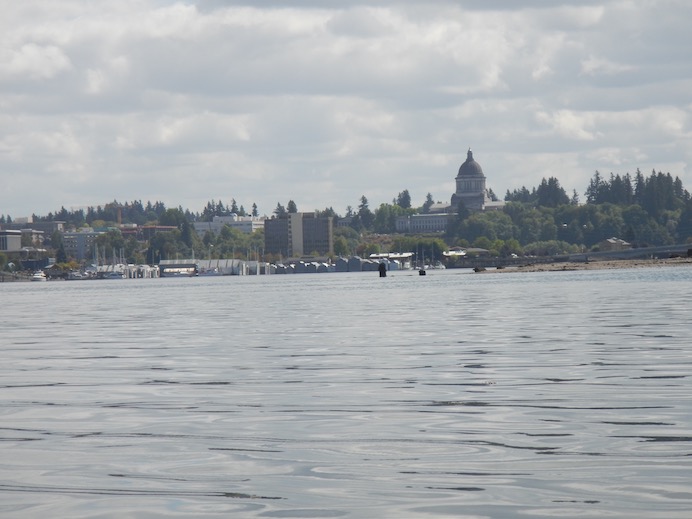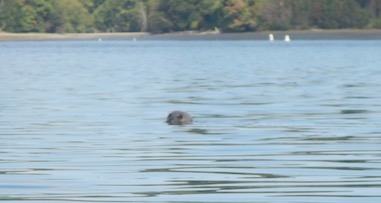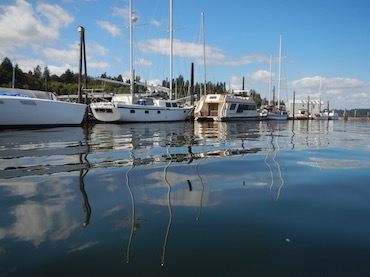Paddling on the Sound
23/08/16 05:15

Almost every year now I get the opportunity to paddle in saltwater. The south Puget Sound is, by my standards, big water, though it is usually very calm and protected. There are several places with convenient launches for canoes and kayaks that are close to our son and daughter-in-law’s home.
Technically, the increased mineral content of ocean water means that a boat displaces a bit less water than in fresh water and therefore floats a bit higher in the water. In a canoe or kayak this difference is not noticeable and the boat perform and paddle just like they do at home.
I do, of course, notice the difference in scenery. At home I usually paddle in the early morning so that I can get to work on time and get in a full day’s work. On vacation, I spend my early mornings with family and get to go out with my boats at mid day when the children have their naps or in the afternoon when the children are available to go with me. Yesterday I went out alone for a short paddle.
In the south Sound, I paddle within sight of the Washington State Capitol building. Although Olympia isn’t a major port for loading and unloading ocean-going ships, it does have a facility for loading timber and there is usually one or more of the big ships in the harbor. The main occupants of the harbor areas are recreational boats, both sailboats and motor cruisers. A few live-aboard boats spend much of their lives in the waters of the sound and can be seen both tied up to docks and cruising the area. Downtown Olympia features Percival Landing, with facilities for visiting yachts and small craft.

One of the joys of paddling out here are the harbor seals. They are very curious and come to check me out when I put my boat in the water. They will swim alongside the boat, but like to keep their distance. Usually they only poke their heads out of the water and they will dive and swim away if my boat coasts too close to them. Yesterday as I paddled two seals kept about 100 feet off of my starboard bow all the way out and on the port side as I returned. I paddled along the shore and the seals kept out in the deeper water of the sound. I’m sure that there are plenty of fish in the water that I’m not seeing. The water isn’t as clear as the lake where I usually paddle, but when the water is shallow I can see the bottom.
One difference out here is the smell. I can see why sailors become addicted to the smell of the ocean. It is alluring and invites a kind of calm and easy breathing approach to life. My style of paddling is very relaxing and I don’t exert myself to the point where I become overly tired.
I’m developing a new habit this summer of washing down and drying my boat each time it goes into the water. My old style was to wash down the boats once a week or so. Out here, it makes sense to get a bit of fresh water and a sponge to wash down the boat each time it is used because salt residue sticks to the boat and makes spots on the finish.
We’ve been made aware of the problems of invasive species as we have traveled, however. The boats I brought all the way to the coast were inspected three times before they went into the water. Montana is having an outbreak of a parasite that is killing fish that they don’t want to spread and both Montana and Idaho are looking for species of snails that aren’t native to their waters and are potentially harmful to native fish and water animals. It is a good habit to make sure that I’m not transporting any plants or animals from one region to another even though I paddle in places that are, as yet, free of the species for which the boats are inspected. I have, in the past, been known to transport mud and sand from one place to another, so it is a good practice to keep the boats clean and dry.

I didn’t need any special clothing for my paddling yesterday, though I did put on a spray skirt to keep splashes from the paddle from getting inside of the boat. The day was warm and the bright sunshine combined with the exertion of paddling to have me sweating in no time.
In the next few days I’ll have time to take the grandchildren for short paddles close to shore and give them a chance to paddle the boats with a short paddle that I have just for them. Combining two of the joys of my life is a real treat and a great pleasure of these days.